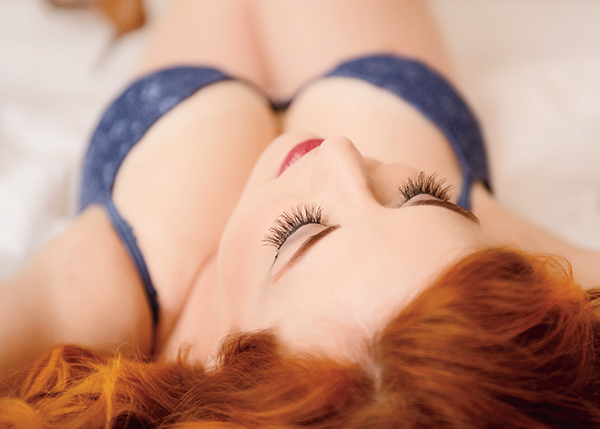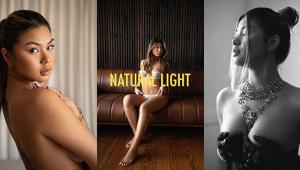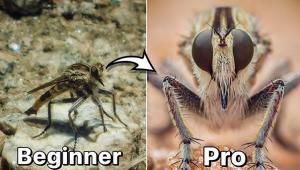The Business of Boudoir: How to Succeed In One of Photography’s Fastest Growing Markets

While previously thought of as a niche, boudoir photography is now a thriving way for photographers to make a living. Usually a gift to a loved one or one’s self, boudoir photography consists of an intimate photo of a woman or man suggestively covered or even fully nude. Although the photographers I interviewed all have different businesses, they all have one thing in common: tremendous kindness and compassion. Thanks to the following photographers for sharing how they have made their businesses a success: Mariah Carle, Lynn Clark, Lindsay Rae D’Ottavio, Megan Drane, Kristi Elias, and Mistie Simone.

Shutterbug: How long have you been in the boudoir photography business? Is it 100 percent of your sales? What other areas of photography do you include in your business?
Kristi Elias: I have been a professional photographer for 19 years. I added boudoir seven years ago and it is now 60 percent of my business. I am a fine art portrait photographer. I photograph people from maternity to boudoir, children, and couples. I specialize in masterpiece portraits.
Lindsay Rae D’Ottavio: In 2015 we made the decision to drop our other areas of photography (i.e., weddings, children, and families) to focus exclusively on boudoir. The more we dug into boudoir, not just as an art form, but as an avenue to empower women to regard themselves more positively, the more we realized the immense amount of time and effort that went into this aspect of our business.
Mistie Simone: My business has been operating since March of 2009 and I am 95 percent boudoir photography and 5 percent pinup, which is practically the same thing. Also, my company is 100 percent Photoshop free.
Lynn Clark: I’ve had my portrait photography business since 2010 and did my first boudoir shoot in October 2010. By mid-2011, I eliminated everything except boudoir, maternity, and headshots. I decided to specialize in boudoir and headshots in mid-2012 once I came to terms with the fact that it is my favorite, and that it’s okay not to shoot everything.
I shoot about 75 boudoir sessions and about 25 headshots a year.
Mariah Carle: I accepted my first boudoir client in 2008. She was a friend of mine who wanted some boudoir photos for her then boyfriend. For sales, boudoir is 50 percent; studio rentals 25 percent; portraits and weddings 20 percent; and nude model for art school 5 percent.
Megan Drane: I had started my photography career with my main brand, Firefly Nights Photography, which is children and families. About six or seven years ago, a client asked me to do a boudoir session for them and that created my second brand specifically for boudoir.

SB: When you are looking at your overall marketing efforts, who are your typical clients and what seems to work best for you? Also, how do you handle pricing—do you list pricing packages on your website?
Mariah Carle: I have no typical client. I work with women, men, transgender, drag queens, soccer moms who want to spice up a marriage, businessmen who want some kinky photos for their favorite fetish, escorts who need new images for their ads. I have had clients who are 20 years old; I have had clients who are 91 years old. The one thing that most of my clients have in common is they express how delighted they are to have found me with my quirky studio, me with my purple hair, me with my vision for stealing their soul. I suggest everyone put their prices on their website along with contact info.
Lindsay Rae D’Ottavio: We shoot almost exclusively women and our clients really don’t fall into one category. We have everyone from the 65-year-old CEO doing a session to celebrate a major milestone, to women in their late 20s to 40s who just had a baby and want to reconnect with their sexual self, to brides who are gifting to their grooms, to the stay-at-home mom who just wants to remember that she is in fact still an incredibly sexy woman at the core of it. I will say we have pretty much figured out where our clients come from based on their age range. Our clients in their early 20s typically come to us from Instagram and our 25+ clients are coming to us from Facebook and word of mouth.
As for pricing, we offer two different ways to book. We offer four prepaid all-inclusive collections that are discounted for advanced purchase and then we offer our “Self Love Experience,” which is the name for our sitting fee.
Kristi Elias: At this point most of my business is referrals, return clients, and a combination of social media and client e-mail promotions. I usually offer the promotions for the first five or 10 who e-mail me as that way there is a sense of urgency and people contact you fast. My typical clients are people who love portraiture or those who are attracted to my style of artwork. The financial demographics of my clients are all over the range, so I offer payment plans for clients who value my work but can’t afford to pay all at once. I only give clients their portraits once I am paid in full.
Megan Drane: While I do advertise some in bridal magazines, I find my best clients are moms. Once women reach a certain age and have had kids, they realize their bodies are never going to get better than they are right now, and people have seen it all (during childbirth), so their modesty has usually diminished. I get a surprising number of women celebrating their 25th wedding anniversaries. My website brings in most clients, but so do client referrals and social media advertisements.
As far as pricing and products, my experience is that most women do not want these images displayed, so I offer different albums for different price points that can be kept for themselves or given as gifts. Occasionally, we sell wall art pieces but by far, most clients purchase albums. These are freely listed on our website, as I only want clients who are comfortable with my pricing to approach us for scheduling a session.
Lynn Clark: My typical clients are women who are at a point of transition in their lives, a point where they are redefining who they are. They’re getting married or getting ready to have kids. They’ve reached a “pivotal” age or anniversary. They’ve had a great loss or a great triumph. My clients tend to be in their mid-30s to their mid-50s. I find that clients who are older tend to have a more transformational boudoir experience. The only marketing that has worked consistently for me is search. I have great SEO for my most important keywords.
In terms of pricing, my website states my session fee and what’s included, then an average and minimum product investment. Once a client has booked, she has access to a section that fully describes products and pricing.

SB: What is your most interesting photography assignment so far—maybe something that was a real learning experience you can share with our readers?
Lynn Clark: In 2014 I had a client ask me to do low-key nudes of her doing yoga poses as one of her sets. I had no experience in that kind of lighting or posing. I told her I was game, but it might not work. She decided to allow me to play and learn. I read, researched, talked with a couple of photographers I know who are really good with lighting, and practiced for a couple of hours. On her session day, her photos were a disaster, so I asked her if I could reshoot. Before her second session, I had another photographer do some tough constructive criticism for me. That was incredibly helpful. I changed my modifier and my settings, I moved my lights a bit, and I made a posing cheat sheet. I improved 100 percent, and my client wound up purchasing a 12-piece canvas collection for her wall, along with a big album and desk art—a $6,500 sale.
Kristi Elias: I had a client many years ago who showed up for a boudoir session. She was a plus size woman (XXX) and showed me an example of a size 2 client I had shown on my website and said she wanted to look like her. All she brought for the session was a G-string, bra, and garter belts. I panicked (calmly). I took the curtains off the window and posed her with them and the fan blowing the curtains to her body in a dramatic way. The learning experience from this moment changed the way I do my boudoir sessions. I went to the fabric store and bought seven yards of fabric in a non-wrinkle material to use for sessions and all my clients loved their images with it.
Megan Drane: I had a woman who’d had open-heart surgery. She was in her late 40s or early 50s. The scar had left her feeling unattractive and really less feminine. Her husband talked her into doing a boudoir session. They made sure that I knew they did not want the scar removed from the images. Instead, they sort of wanted to focus on the scar to show that she was still beautiful and feminine even with the scar running down her chest. I never allow men to be present in the studio during boudoir sessions, so he was not there, but she was full of smiles afterward, telling me that she felt beautiful. When I showed her a photo of her leaning against the wall with her button-down shirt open, revealing both the scar and one breast, she finally saw herself and no longer her scar. It was a changing moment for her, and it greatly touched me.


Resources
Mariah Carle: carlephotography.com
Lynn Clark: denverboudoirphotos.com
Lindsay Rae D’Ottavio: photographybylindsayrae.com
Megan Drane: fierynightsboudoir.com
Kristi Elias: kristielias.com
Mistie Simone: littleblackdressboudoir.com
















































